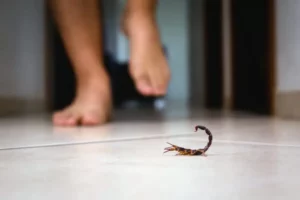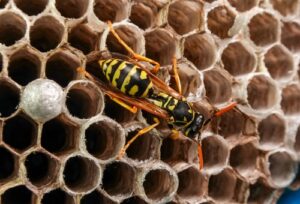Home / Blog / Ants / What Do Carpenter Ants Eat?
What Do Carpenter Ants Eat?

Scientifically reviewed by Rachel Maldonado
-Published on September 16, 2024
-Updated on October 29, 2025
If you think you might be dealing with carpenter ants, you’ve probably asked yourself, “what do carpenter ants eat?” Spoiler alert: it’s not wood. Like many other ant species, carpenter ants consume food scraps, other insects, and sugary substances. Here’s what you need to know.

What Are Carpenter Ants?
Carpenter ants are a common type of ant known for their wood-destroying habits. Unlike termites, what carpenter ants do to wood is carve it—not eat it. They excavate tunnels and galleries inside wood to create their nests, leaving behind smooth pathways that almost look machine-made.
Carpenter ants are usually black or red, larger than the average house ant, and are most attracted to moist, decaying wood. That makes areas like leaky basements, wet rooflines, and rotting wood decks prime real estate.
They don’t limit themselves to just wood, either—they can also nest in insulation, wall voids, and even inside hollow doors. In short: if there’s wood and moisture, carpenter ants are interested.
The Carpenter Ant Diet
What do carpenter ants eat? Not wood. Although they burrow through wood to create their nests, they don’t actually ingest it—carpenter ants just chew it up and spit it out.
So what’s actually on the menu?
- Sugary substances like nectar, syrup, honeydew (a sweet substance excreted by aphids), and anything sweet left in your pantry.
- Protein sources like dead insects, kitchen scraps, pet food, and even meat products.
- Water—like any other pest, they need moisture to survive, so they seek it out near sinks, pipes, and other damp places.
Eating Habits of Carpenter Ants
In warmer months, carpenter ants are busy foraging to feed the colony. That’s when you’re most likely to spot them looking for sweets and proteins in and around your home.
When temperatures drop, they typically go dormant unless they’ve nested indoors in a warm area. In that case, they may remain active year-round—making winter infestations especially sneaky and frustrating.
Signs of a Carpenter Ant Infestation
How do you know if you’re dealing with carpenter ants? There are a few signs to watch for:
- Sawdust or wood shavings near walls, baseboards, or wooden structures
- Rustling or faint clicking noises inside walls, especially at night
- Foraging trails—lines of ants moving to and from food or water sources
- Winged ants (swarmers) appearing in spring, which likely indicates a mature nest nearby (more about signs of carpenter ants here)
How to Get Rid of a Carpenter Ant Infestation
Now that you know what carpenter ants eat, let’s talk about how to stop carpenter ants before they cause structural damage.
Your best option? A multi-step approach:
- Eliminate food and water sources: Clean up spills, store food in sealed containers, and fix leaks.
- Remove damaged wood: Replace rotting or water-damaged areas inside and outside your home.
- Use bait traps: These allow ants to carry poison back to the colony, helping eliminate it at the source.
- Seal entry points: Caulk gaps, fix screens, and close off small openings around doors and windows.
How Long Does It Take to Get Rid of a Carpenter Ant Infestation?
Depending on the severity and location of the infestation, it can take up to several weeks to fully eliminate carpenter ants. Surface-level treatments may kill foragers, but unless the nest is destroyed, they’ll keep coming back.
Professional exterminators can identify the colony, apply targeted treatments, and follow up to ensure it’s completely removed.
How to Prevent Carpenter Ants
Once you’ve cleared an infestation, your next goal should be long-term prevention. Here’s how to prevent carpenter ants from coming back:
- Keep your home dry: Fix plumbing leaks, use dehumidifiers in damp areas, and redirect water away from your home’s foundation.
- Seal entry points: Use weather stripping and caulk to close gaps in doors, windows, and siding.
- Eliminate outdoor wood attractants: Remove decaying stumps, stacked wood, and brush piles near your home.
- Maintain cleanliness: Wipe down surfaces, take out the trash frequently, and store food securely.
Remember: Regular home maintenance is your best defense against future infestations.
Take the Next Step with Hawx Pest Control
Carpenter ants aren’t just an annoyance—they can compromise your home’s structural integrity and cause plenty of expensive damage if left untreated. If you’re ready for a long-term solution, the professionals at Hawx Pest Control are here to help. Our team knows how to stop carpenter ants in their tracks—from identifying the nest location to eliminating the colony and helping you keep them out for good.
Reach out to Hawx today for your free estimate and protect your home from the inside out.
Related Articles
Visit our blog to learn more.
→







